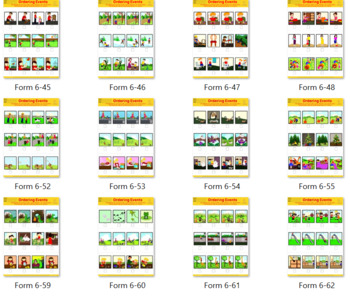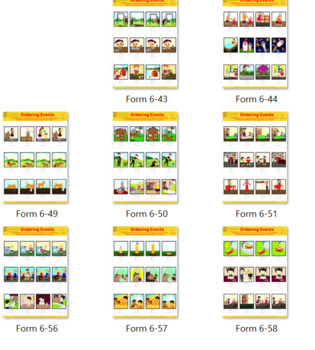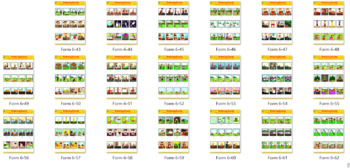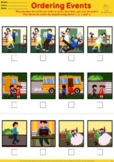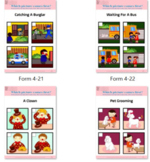ORDERING EVENTS, 4 PICTURES, Sequence, Sequencing, ABA, 240 pictures, 3 OF 3
- PDF
What educators are saying
Also included in
- 180 WONDERFUL SEQUENCING STORIES WITH 720 PICTURES INCLUDED IN THIS BUNDLE.Do you know a child who is not able to set the table? The child struggles with what should be done first and where everything goes. Do you know a child who can’t follow the specific “order” of steps to solve math problems corPrice $12.80Original Price $24.00Save $11.20
- Do you know a child who is not able to set the table? The child struggles with what should be done first and where everything goes. Do you know a child who can’t follow the specific “order” of steps to solve math problems correctly? Do you know a child who struggles to tell you about their school daPrice $31.20Original Price $78.00Save $46.80
- THIS MEGA MEGA BUNDLE IS SO FANTASTIC THAT YOU SHOULD NOT MISS.IT TOOK ME THREE YEARS TO CREAT AND IT IS OUTSTANDING!There are all together 1400 pages with beautiful colours and pictures. Your kids will love them!Do you know a child who is not able to set the table? The child struggles with what shoPrice $120.00Original Price $358.00Save $238.00
Description
60 WONDERFUL SEQUENCING STORIES WITH 240 PICTURES INCLUDED IN THIS SET.
Sequence, Sequencing Stories, speech therapy, 60 stories with 240 pictures, ABA
Do you know a child who is not able to set the table? The child struggles with what should be done first and where everything goes.
Do you know a child who can’t follow the specific “order” of steps to solve math problems correctly?
Do you know a child who struggles to tell you about their school day? When they try to tell you about it, their story may be jumbled and hard to follow.
If yes, then these kids may have trouble with sequencing. Sequencing is such an important tool to learn for our students because it affects their ability to tell a story, comprehend a book, retell a story they read, order events to make a plan, or tell you about something they did. That is why sequencing has a huge impact on literacy, language, communication, and social interaction. It is a must-teach skill in a developmental curriculum.
Language is the very first thing kids learn to sequence. They know that when they use words and sounds in a particular order, they get certain results. Language issues aren’t the only reason for trouble with sequencing tasks. Working memory issues cause some children to lose hold of the proper order of doing things.
Teaching sequencing is considered one of the most important things in speech therapy. It is a critical communication and life skill. Sequencing is the process of combining things in a particular order – the following of one thing after another. In the context of speech and language, sequencing refers to a skill that we use to discover the components of an event and break it down into simple steps, such as the beginning, the middle and the end of an event. It also refers to the ability to align thoughts, language, knowledge, information or actions in a certain order and retrieve them to complete a given task.
We use sequencing skills in all areas of our life and don’t even realize it. You use these skills to follow multi-step directions, complete a math problem, break a big task into small tasks, form complete sentences with the correct syntax, or to retell a story.
Our sequencing stories are teacher-approved for language and speech therapy students. Each story contains four pictures with simple sentence descriptions. These will strengthen our children’s sequential auditory skills as well as logical thought and visual memory process. Our children will improve their communication skills as they retell each story in their own words.
Sequencing skills are an important part of language development. The ability to sequence is one of many skills that contributes to students' ability to comprehend what they read. Sequencing is a foundational skill to many aspects of language, executive functioning skills, and other areas of academics. Sequencing is a common area that children struggle with. If they don’t develop a strong foundation when they are young, it’s easy to get behind and it can affect many areas of their lives. Sequencing difficulties can be a result of language deficits, executive functioning issues, or lack of attention skills.
Sequencing is the ability to arrange language, thoughts, information and actions in a certain order to get things done. Without this skill, it’s hard to complete tasks correctly. And it’s often the reason why some kids seem unable to follow simple directions.
It is very likely that trouble with sequencing language will cause problems for the child down the line. Without those early skills, kids have a harder time developing a natural sense of how other things should be ordered. Younger children who have trouble with sequencing often struggle with sequences of pretend play. They might also say sentences in a muddled order or say things that seem unrelated to the topic.
Older or more verbal children who struggle with sequencing often find it hard to tell a story or a piece of news; as they jump backwards and forwards and miss important parts out. They might not be able to answer the question they were asked or may waffle and fail to come to the point.
Sequencing is also an important reading comprehension strategy. It allows students to make sense of how events unfold in their reading. In turn, these reading skills will help students in their own writing. It will help them to construct a cohesive and logical flow to their writing that readers can easily follow.
Strong sequencing skills help students:
○ With their reading comprehension of a text, especially narrative texts.
○ Understand the structure of a text and how it is put together.
○ Understand how texts are kept cohesive through the use of linking devices such as connectives and transitions.
○ Organize information and ideas in their own writing.
○ Develop problem-solving skills that are important in other curriculum areas too.


